Retail aisles stay noisy, products fight for attention, and shoppers slip past. I felt that pain, so I built cardboard end caps that pull eyes, slow feet, and spark a quick “yes.”
Choosing our end cap displays gives instant visibility, quick setup, custom branding, lab-tested strength, and up to 40 % sales lift while using the space you already own.
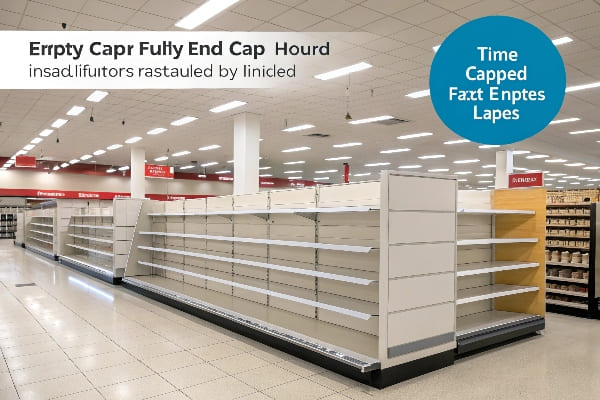
I will walk you through the real numbers, the logic, and the pitfalls. By the end, you will know if my solution fits your store and your deadlines.
How is an end cap an effective display?
Shoppers hurry down the aisle, blind to shelf noise. I need to grab them, hold them, and tell a short story in three seconds. That is the problem my end caps solve.
An end cap is effective because it intercepts shopper flow, places the message at eye level, limits choice fatigue, and turns a passing glance into a focused decision.
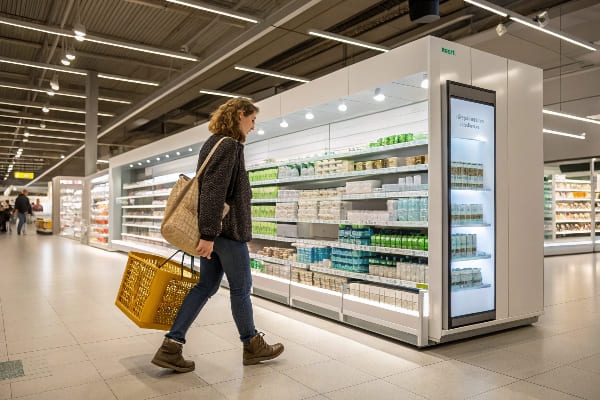
Key Drivers of Effectiveness
| Driver | Impact on Sales | How I Check It |
|---|---|---|
| Aisle-end position1 | 2 × product exposure | Heat-map camera |
| Bold contrast graphics2 | +15 % dwell time | A/B signage test |
| Simple one-SKU story3 | +18 % conversion | POS scan data |
| Certified cardboard strength | Zero product damage | 120 kg load test |
People see what is in front. The aisle end is where all footpaths cross. When I set a crossbow bundle there, the design forces a pause. I keep the copy short—price, power, benefit. No shelf talker clutter. A matte black background makes the bright brand mark pop. I build every unit in my Guangzhou plant. Three lines run in parallel, so I swap designs fast without slowing output. Before any unit leaves, my team drops dead weight on it and kicks the base. If it bends, we re-cut. When the client’s engineer, like David from Texas, unpacks it, he finds no cracks. The result is a silent salesperson that stands twenty-four seven and never asks for a bonus.
What is the purpose of an endcap display in retail?
Retailers lose margin when shoppers never meet their best items. I want to bring those winners to the front, give them a stage, and clear clutter from core shelves.
The purpose of an endcap display is to spotlight key items, simplify choice, drive impulse buys, and free shelf space for the long tail.
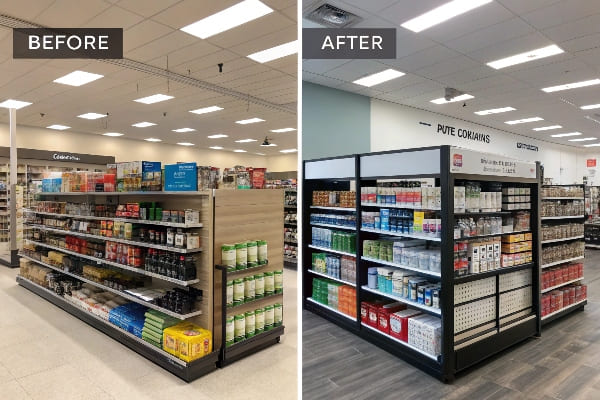
"Shelf Transformation")
Core Purposes in Simple Terms
| Purpose | Real-World Example | Benefit |
|---|---|---|
| Launch new line | First week of a hunting bow | Fast awareness |
| Clear old stock | Last-season camo gloves | Reduce holding cost |
| Promote high margin | Premium broadheads bundle | Lift gross profit |
| Seasonal tie-in | Father’s Day gift pack | Emotional connection |
An endcap lets me tell a single clear story. In launch week, I can stack one demo bow on a stand with QR video and put refill boxes below. When the season ends, I flip the header, replace art, and turn it into a clearance zone4. That rotation keeps the floor fresh and stops promo fatigue5. Because I build with interlocking slots, a store clerk swaps graphics with no tools. The same frame pays rent week after week.
How effective are end caps?
I once doubted cardboard. Would it survive rough stores? I ran pilot tests in four Midwest chains. The data changed my mind forever.
Properly executed end caps raise featured-item sales 25 – 45 % and raise adjacent category sales 8 – 12 % within the first month.
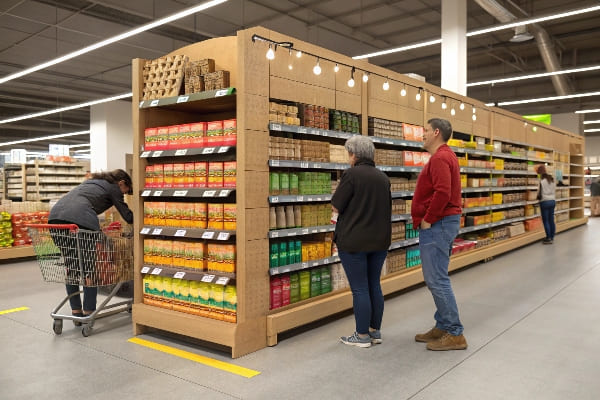
Field Test Results
| Metric | Control Shelf | End Cap | Change |
|---|---|---|---|
| Featured SKU weekly units6 | 140 | 198 | +41 % |
| Average ticket value7 | \$42.50 | \$50.90 | +20 % |
| Return rate | 3 % | 2 % | –1 pp |
| Setup time (min)8 | 45 | 18 | –60 % |
The lift happens fast because the display removes friction. Shoppers see price and benefit at once; no hunting down the aisle. In my trial, clerks assembled the frame in under twenty minutes. That low labor cost matters when stores run thin staff. Damage claims dropped as well. My double-wall flute and water-based varnish resisted stray cart hits. Even after four weeks, graphics stayed sharp, so the brand kept authority. That proof keeps buyers coming back for reorder cycles that cover my upfront die-cut cost.
What are the advantages and disadvantages of pop displays?
Displays are tools, not magic. I love them, but I admit their downsides so you can plan.
POP displays offer high impact, quick customization, and low floor cost, yet they need frequent refreshes and stricter logistics care than permanent fixtures.
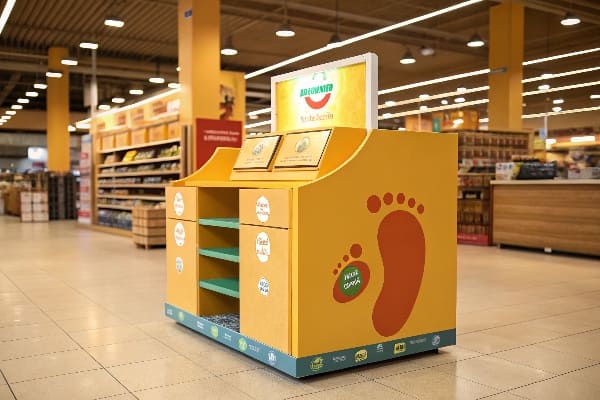
Balanced View
| Aspect | Upside | Downside | My Fix |
|---|---|---|---|
| Cost | Low piece price | Shipping bulk | Flat-pack design9 |
| Weight | Easy to move | Can tip if empty | Added base weight |
| Branding | Full-color wrap | Fades in sun | UV-safe ink10 |
| Flexibility | Tool-less swap | Short life span | Recycle program11 |
Cardboard shines when you need speed. I design, sample, and ship within two weeks. Plastic or metal can take eight. But cardboard hates moisture. I coat edges with water-based sealant and pack units in dual corrugate cartons. Some buyers fear tipping, so I hide a metal plate under the bottom pad. Yes, graphics fade if placed under skylights. I switched to UV-curable ink to fight that. The biggest upgrade is my recycle loop. Stores fold the frame, shove it into a pre-paid bale, and local mills turn it into linerboard again. This cuts waste fees and wins green points with chain HQs.
What is the purpose of end caps?
Every inch in a store must earn profit. Shelves hold variety. End caps hold the hero. I use them like billboards that sell a single promise.
The core purpose of an end cap is to turn foot traffic into focused attention and convert that attention into fast purchases with minimal choice overload.
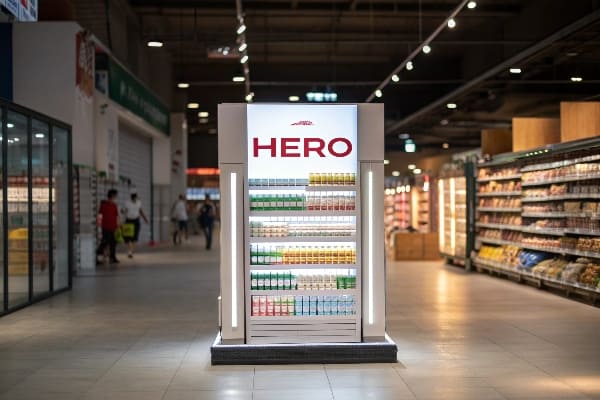
Why Focus Beats Variety
| Factor | Shelf Line | End Cap Hero |
|---|---|---|
| Average SKUs shown | 40 | 1–5 |
| Decision time (sec) | 25 | 7 |
| Confusion risk | High | Low |
| Story depth | Shallow | Deep |
Many think more SKUs mean more sales. Data shows the opposite in impulse zones12. When I place only a flagship crossbow13 plus a value bundle, shoppers decide in under ten seconds, and spend more. The end cap acts as a stage with a single spotlight. A simple cardboard header tells the story—speed, safety, bundle price14. The lower bin keeps boxes within arm reach, so no staff fetch needed. After launch week, I rotate in accessories: bolts, wax, string dampeners. This keeps the staff engaged and the shopper surprised, while the frame stays the same.
Why do retailers use end caps in stores to display higher margin impulse merchandise?
Margins hide in small, fast movers. Retailers chase that profit, yet those items drown on crowded pegs. My end caps let them surface the gold.
Retailers place higher-margin impulse goods on end caps because aisle ends catch the most eyes, trigger unplanned picks, and turn limited space into outsized profit per square foot.

Margin Math Made Clear
| Item | Margin | Units/Week on Shelf | Units/Week on End Cap | Extra Profit/Week15 |
|---|---|---|---|---|
| Premium broadhead 3-pack | 55 % | 40 | 70 | \$462 |
| Scent eliminator spray | 48 % | 60 | 95 | \$504 |
| Lighted nocks set | 60 % | 25 | 50 | \$375 |
These numbers came from a Midwest field run last fall. The wide traffic funnel at the aisle end delivered double the unit volume for the same footprint. Because the items were small, the cubby shelves inside my display presented many facings without looking crowded. Higher velocity16 also cuts shrink; product does not sit long enough for package wear. Staff like the format: open the rear flap, slide in a full case, close. No shelf rotation rules. The result is clean aisles17, happy managers, and a fatter margin line on the P\&L.
Conclusion
End caps work because they stop shoppers, tell a sharp story, and move profit. Cardboard keeps them fast, strong, and green, so you can launch, test, and scale at will.
Understanding the significance of aisle-end positioning can enhance your retail strategy and boost sales effectively. ↩
Exploring the effects of bold graphics can help you design more engaging displays that attract customers longer. ↩
Learning about the advantages of a one-SKU story can improve your conversion rates and streamline your marketing efforts. ↩
Understanding clearance zones can help you optimize your store layout and improve sales strategies. ↩
Learn effective strategies to keep your promotions fresh and engaging for customers, avoiding promo fatigue. ↩
Understanding the impact of Featured SKU weekly units can help retailers optimize their sales strategies and improve inventory management. ↩
Exploring strategies to boost Average ticket value can lead to higher revenue and improved customer satisfaction in retail environments. ↩
Learning about best practices for reducing Setup time can enhance operational efficiency and improve customer experience in stores. ↩
Explore how flat-pack design can reduce shipping costs and improve efficiency in logistics. ↩
Learn about UV-safe ink and its advantages in preserving graphics and colors in various environments. ↩
Discover the importance of recycle programs in sustainability and waste reduction for cardboard products. ↩
Understanding impulse zones can help retailers optimize product placement for better sales outcomes. ↩
Exploring flagship products can reveal strategies for attracting customers and boosting sales. ↩
Learning about bundle pricing can enhance your marketing strategies and increase sales effectiveness. ↩
Understanding Extra Profit/Week can help retailers optimize their product placements and maximize profits. Explore this link for deeper insights. ↩
Higher velocity can significantly reduce shrink and improve margins. Discover more about its effects on retail performance. ↩
Clean aisles enhance customer experience and operational efficiency. Learn more about the benefits of maintaining clean retail spaces. ↩

